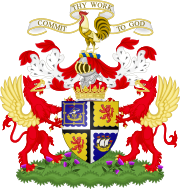Earl of Caithness facts for kids
Quick facts for kids Earldom of Caithness |
|
|---|---|
 |
|
| Creation date | c. 1334 |
| Peerage | Peerage of Scotland |
| First holder | Maol Íosa V, Earl of Strathearn |
| Present holder | Malcolm Sinclair, 20th Earl of Caithness |
| Heir apparent | James Richard Sinclair, Lord Berriedale |
| Remainder to | heirs general of the body of the grantee |
| Subsidiary titles | Lord Berriedale |
| Seat(s) | London |
| Former seat(s) | Castle Sinclair Girnigoe |
The Earl of Caithness is a special title in Scotland. It's part of the Peerage of Scotland, which means it's a very old and important noble rank. This title has been created several times over history, making its story quite interesting and a bit complicated!
The first time this title was officially given, in a way we count today, was around 1334. It went to a person named Maol Íosa V, Earl of Strathearn. However, just one year later, he lost all his titles. This happened because he was accused of treason, which means he was seen as disloyal to the king.
Contents
What is an Earldom?
An earldom is a very old type of noble title. It's like being a count or a duke in other countries. The person holding the title, an Earl, usually had control over a certain area of land. In this case, it was the area of Caithness in northern Scotland.
A Long and Changing History
Before the official "earldom" title, the land of Caithness was sometimes ruled by Norse leaders. These were Viking people from Norway. They were known as the earls of Orkney and had power in the area.
After Maol Íosa lost the title, it was given to David Stewart, who was a younger son of Robert II of Scotland. David's daughter, Euphemia, later gave up the title in 1390. She passed it to her uncle, Walter Stewart, Earl of Atholl. Walter also gave up the Caithness title later, in 1428, to his son Allan. But Walter kept his other title, Earl of Atholl.
When Allan died, Walter became Earl of Caithness again. However, in 1437, Walter was executed for treason. This meant he lost all his titles, including the Earldom of Caithness.
New Beginnings for the Title
The title was created a third time in 1452 for Sir George Crichton. But he only held it for a very short time, giving it up in the same year.
The most lasting creation of the earldom happened in 1455. This time, it was given to William Sinclair, 3rd Earl of Orkney. He made an important deal with King James III in 1470. William gave up his Orkney title and all the lands that came with it. In return, he received Ravenscraig Castle in Fife.
This deal was important for Scotland. King James III had recently gained rights to the Orkney islands from the King of Norway. By getting William Sinclair to give up his Orkney title, the Scottish king gained more control over Orkney and Shetland. These islands had been Norwegian territories before.
Later, Earl William wanted to make sure his oldest son, who was known as "the Waster," would not inherit the Caithness title. So, in 1476, he gave up the title. He made sure it would pass to his second son, also named William, from his second marriage.
Changes and Stability
For a while, the title passed down through the Sinclair family. However, George Sinclair, 6th Earl of Caithness, caused a bit of a stir in the 1600s. In 1672, he agreed that when he died, his lands and titles would go to Sir John Campbell. Sir John was someone George owed money to.
When the sixth earl died in 1677, King Charles II even made Sir John Campbell the Earl of Caithness. But then, the sixth earl's rightful heir, also named George, was confirmed as the true Earl by law. To make up for this, King Charles II gave Sir John Campbell a new title: Earl of Breadalbane and Holland.
Since then, the Earldom of Caithness has stayed within the Sinclair family. There haven't been any more big changes or unusual transfers of the title.
Lord Berriedale
The Earl of Caithness also holds another title called Lord Berriedale. This title was created in 1455. It's often used as a courtesy title for the Earl's oldest son. This means the son uses "Lord Berriedale" as his main title until he might inherit the Earldom of Caithness himself.
The current Earl is Malcolm Ian Sinclair, 20th Earl of Caithness. His son, Alexander James Richard Sinclair, is the heir apparent and is known as Lord Berriedale.

